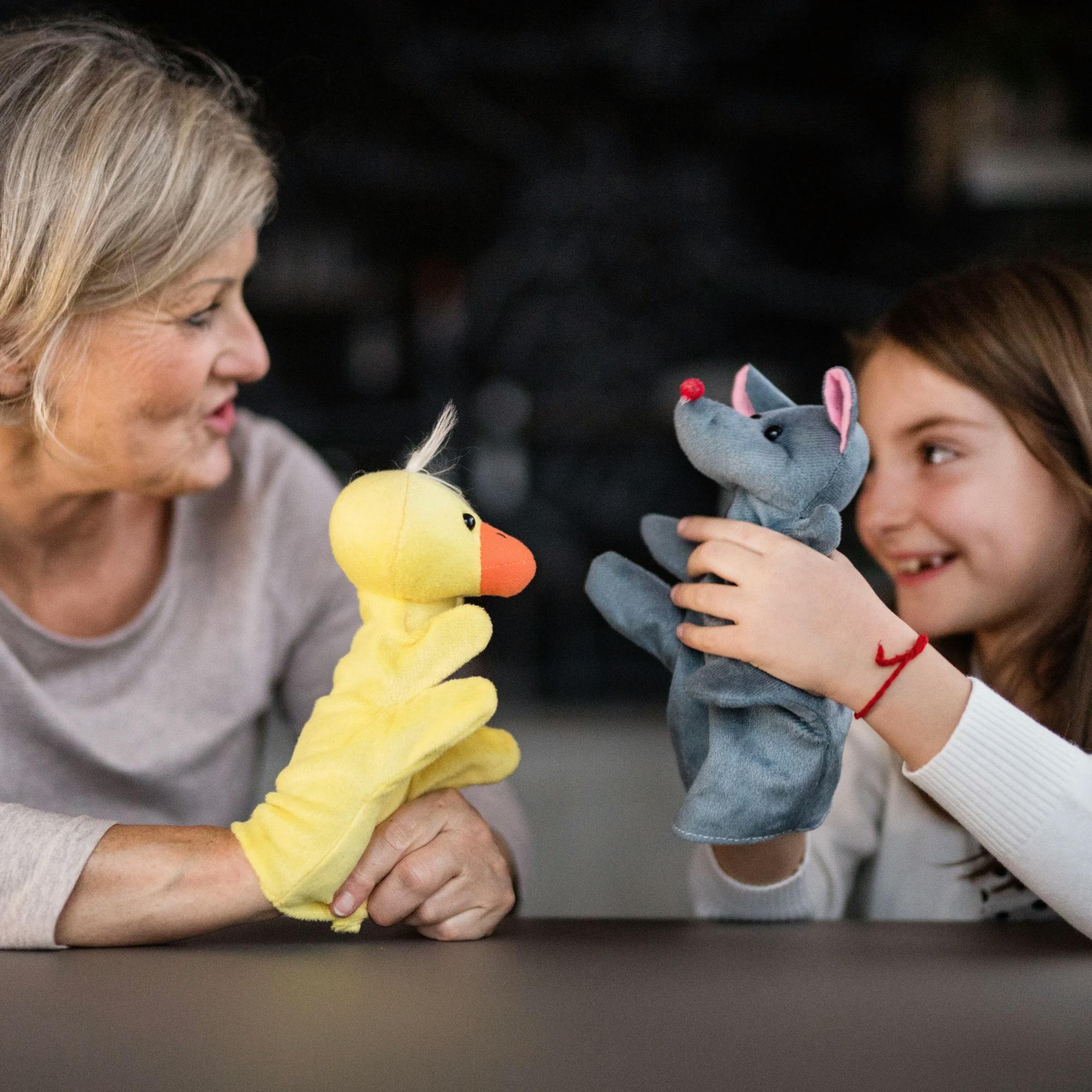Does your child have a hard time making the /v/ sound? If you’ve heard them say something adorable like “I’m berry hungry!”, chances are they may have some trouble with this sound.
For some children, making the /v/ sound is tricky. The good news? There’s lots you can do to teach your child at home and help them improve their speech sounds. If home practice isn’t enough, speech therapy can help your child speak more clearly.
When should kids be able to say the /v/ sound?
Children should be correctly pronouncing /v/ sometime during age 4. Some children may begin to say this sound earlier, but being able to make the /v/sound before age 5 is the goal.
It’s important to know that the longer you wait to begin helping your child with their pronunciation, the more difficult it can become to correct errors and improve their speech. This is because motor patterns (the mouth movements we use to produce sounds) become more ingrained as a child gets older. In other words, the longer a child is used to mispronouncing a sound, the harder the habit is to break.
Is your child ready to practice the /v/ sound?
Wondering if your child should be practicing the /v/ sound? Consider whether your child is able to imitate a correct production of this sound. In other words, if you show them how to say a correct /v/ sound, can they repeat it back to you? If so, they’re probably ready to begin working on this sound.
However, If your child is getting close to their fourth birthday and still doesn’t seem ready to begin practicing the /v/ sound, it’s OK to go ahead and start working on it. Simply bringing their attention to this sound may help them get closer to pronouncing it.
It’s important for kids to be able to speak as clearly as possible when they start preschool or kindergarten. A child who’s 3 or 4 will soon start to be surrounded by new people, like teachers and peers. If their speech is hard to understand, this could deflate their confidence and make them less likely to communicate. As you can imagine, having people constantly ask, "What did you say?" or "Can you say that again?" can become pretty frustrating!
Plus, of course, kids need to be able to communicate clearly for safety reasons. That’s why the more you can do to help your child with their speech, the better prepared they’ll be to communicate clearly with lots of different people.


How to say the /v/ sound
Here are the steps to teach a child to make the /v/ sound:
1. Place your top teeth on your bottom lip, almost as if you’re biting it.
2. Turn the voice on. This means your throat will vibrate with sound.
3. Direct the sound out the front of the mouth.
One benefit of the /v/ sound is that it’s visual. This means kids can look in the mirror and easily see if their mouth is in the right spot. You may need to help them at first, but a mirror will be a helpful tool for this.
You can think of the /v/ sound as similar to the /f/ sound. If your child can say the /f/ sound, explain to them that their teeth and lips go in the same position for /v/. The difference with the /v/ sound is that the voice is turned on. /f/ is a voiceless sound, so there is no vibration in the throat, only airflow. But the /v/ sound requires vibration in the throat.
Some children mix up the /v/ sound with the /b/ sound. So vacuum may sound like bacuum, or very may sound like berry. You can tell your child that /v/ is similar to /b/. The voice is on for both of them. But for /v/, the top teeth are placed on the bottom lip, instead of the lips coming together as they do for the /b/ sound.


How to practice the /v/ sound at home
In the section above, we reviewed how to help your child say the /v/ sound in isolation, or by itself. As your child begins to master this, it's time to start practicing the /v/ sound in syllables, words, sentences, then everyday conversations.
Keep in mind, it will likely take some time for the /v/ sound to be 100% accurate in your child’s speech. Fortunately, there are many tips and techniques you can use to get your child to this next step of their speech development.
After your child is saying the /v/ sound on its own, start practicing combining /v/ with syllables. These are often just made-up syllables, such as “vee,” “vay," “vie," “vo," and “voo.”
This helps get your child ready to practice /v/ in words, the level that comes after syllables.


Words for practicing the /v/ sound
When your child is ready, start with single-syllable /v/ words, like:
Van
Vote
Vest
Verse
Veil
Then, move on to practicing two- and three-syllable words, like:
Visit
Visor
Valentine
Vacation
Vegetable
After your child has started saying /v/ in words accurately, it's time to start using these words in two- and three-word phrases. Over time, increase the phrase length until they're able to fully incorporate /v/ words into sentences and, eventually, conversations.
You’ll also need to practice this progression through words that have /v/ in the middle, like oval or heavy, or words that end with /v/, like have or save.
Progress doesn't happen overnight. It will take steady practice and persistence to get to the conversation level. Make sure to give your child the time and attention needed at each level before moving on to the next one. You will know your child is ready when they're 90% accurate at each level.

What if your child gets frustrated during speech practice?
Children are aware when they struggle to pronounce sounds. It's likely your child may get annoyed or frustrated at some point as you practice together. Make sure you give them a lot of praise and encouragement.
You shouldn't say “Great job!” when your child pronounces something wrong. This can confuse them and decrease their ability to self-correct their errors. But there are plenty of ways to encourage your child while also giving them the right feedback. Here are some examples:
“I love how you’re trying! That’s not quite it. Let’s try again!”
“You're working so hard! Next time remember to turn your voice on.”
“You are so close! That’s not quite it, but I know you'll get it soon.”
When your child does pronounce the /v/ sound clearly, make sure you recognize and point out their progress. Give them lots of praise! They’ll love seeing your reaction, and it will reinforce that the speech production they just made is the right one. As long as you keep practice positive and engaging, your child will be more motivated to participate.
When should you contact a speech therapist?
If your child is having a hard time learning to make the /v/ sound, or they can pronounce it in syllables but not quite in words, it’s a good idea to contact a speech therapist for an evaluation. Speech therapists are experts in articulation, or speech sound issues. A speech therapist can create a treatment plan individualized to your child. The sooner speech therapy begins, the sooner your child can start making progress!
During the evaluation, the speech therapist will assess your child’s speech errors. They’ll then create a plan of care to help your child progress along each level of learning a speech sound. As therapy continues, they'll monitor your child’s speech and measure their percentages of accuracy, as well as how much help they need to make the correct /v/ sound production.
Your speech therapist will also give you helpful exercises and tips for practicing at home. They’ll be with you for guidance and support every step of the way!
How Expressable Can Help
Concerned your child isn't reaching age-expected milestones? Looking for communication support from a professional? Expressable is a national online speech therapy practice serving children and adults. We treat all major areas of communication and feeding, offer flexible hours including evenings and weekends, and accept most major health insurance plans. We’re proud to have earned more than 3,000 5-star reviews from our clients (4.9/5 average).
Our therapy model is centered on parent and caregiver involvement. Research proves that empowering caregivers to participate in their loved one’s therapy leads to better outcomes. That’s why we combine live, 1-on-1 speech therapy with personalized education and home practice activities for faster progress.
Communication is more than words. It’s how we share how we feel and show who we are. We’re here to help you or your child do just that.

 Abby Barnes, M.S., CCC-SLP
Abby Barnes, M.S., CCC-SLP










